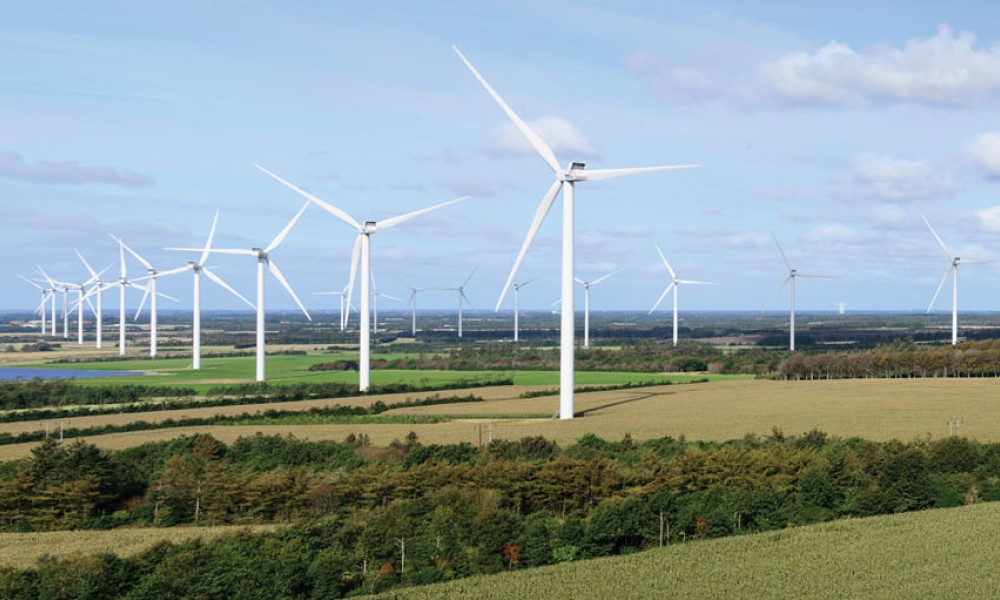
One of the biggest global challenges in the coming decades will be the transformation from fossil-fuel dependency into self-sufficiency by the use of renewable energy. The Danish municipality of Ringkøbing-Skjern will reach the 100-percent target by 2023.
The scene is set in Ringkøbing-Skjern, a coastal municipality at the windswept shores by the North Sea in Scandinavia. The municipality has approximately 57,000 inhabitants (38 per square kilometer) and a surface area of 1,500 square kilometers (579 square miles). Gross domestic product per capita is US$66,000—a remarkable 23 percent above the Danish average.
Ringkøbing-Skjern was formed in 2007, due to a structural reform in Denmark, uniting five municipalities. From the very beginning, sustainability, renewable energy, and environmental protection became the uniting forces among politicians, organizations, innovators, businesses, and citizens alike. It was no coincidence that these topics mattered a great deal to us. Vestas, the energy industry’s global leader in sustainable energy solutions, was founded in Ringkøbing-Skjern. In the 1970s, Vestas began to produce wind turbines, and since then renewable energy has been a proud part of our local DNA and history.
One of the first important tasks of the then-newly elected city council in 2008 was the formulation and implementation of a very ambitious energy policy. Our ambition was to become self-sufficient in renewable energy by 2020. With our history in mind, it was obvious that we wanted to be a role model for other municipalities around the world—for a better and greener world.
During the 12 years from 2008 to 2020, we experienced many successes but also a major setback. The deployment of 20 large coastal wind turbines in 2020 was crucial to our ability to cross the finish line in time, but unfortunately they were delayed. The coastal wind farm will be able to supply electricity equivalent to the annual electricity consumption in 170,000 Danish households. The Danish state owns the wind farm, but the production of green electricity has a positive impact on our energy accounts, as the city council has welcomed the wind turbines within our municipal boundary. The consequence of the delay is that we will not reach the target until 2023. It’s no disaster. Imagine if we had done nothing at all back in 2008—that would have been a disaster.
The Energy Council and Secretariat
As previously mentioned, the city council adopted an energy policy in 2008. It was named Energy2020 and the policy contained the political ambitions and visions. It was an important point of departure, but even an ambitious policy cannot stand alone. We set up an energy council and an energy secretariat. There are 18 members of the energy council. Just two members are city council members, the rest are representatives from the public utility companies, businesses, and organizations.
Although the energy council is set up by the city council, it has been important from the outset that the energy council should include professionals with the ability to advise. The energy council concluded that the following should be focused on if the ambition to become 100-percent self-sufficient in renewable energy was to be realized: wind energy, solar energy, biogas, green transportation, and energy-efficient buildings.
Soon after, the energy secretariat was set up. The energy secretariat facilitates and coordinates processes and tasks, helping all interested parties with guidance and inspiration. The secretariat is also responsible for information and preparation of the strategic energy plans, as well as following up on the energy accounts.
Strategic Energy Plans
The strategic energy plans are the masterplans. The first strategic energy plan was adopted in 2010 and it covered the period from 2011 to 2014. The plan included the first concrete steps in the long-standing efforts to become self-sufficient. The deployment of wind turbines requires long-term physical planning and many hours of dialogue and cooperation with local stakeholders. Local acceptance is crucial. In addition, it is important to establish stability and security for investors, developers, and producers, which also requires long-term policy targets.
The second strategic energy plan was adopted in 2015 and covered the period from 2015 to 2018. A strategic energy plan contains many elements and in practice, it may be difficult to start all elements of the plan immediately. In 2015, we were more than half way toward the objective of making Ringkøbing-Skjern 100-percent self-sufficient in renewable energy. Our local actions are, however, often heavily dependent on national framework conditions, which can either boost or slow down the results. Lack of impact in one focus area will require a higher ambition level in other focus areas. Therefore, the first strategic energy plan had to be revised and exposed to new priorities.
The revised strategic energy plan was also a result of the city council having just adopted a new vision called Nature’s Kingdom, which states that our nature is the source of the good life. Our desire for sustainability and self-sufficiency was emphasized even further in the vision of Nature’s Kingdom.
The third and current strategic energy plan was introduced in 2019 and it covers the period from 2019 to 2023. This strategic energy plan contains not only plans for how we will become self-sufficient in renewable energy, it also includes a newly adopted plan for how we will become fossil-free. The Danish government has decided that Denmark must be fossil-free in 2050, but we aim to achieve this already by 2040.
The current strategic energy plan is based on a revised energy policy adopted by the city council in 2019. Ringkøbing-Skjern is fully committed to the United Nations’ 17 global goals, and the energy policy and the strategic energy plan are no exceptions. When it comes to our strategic energy plans, such global goals as “affordable and clean energy,” “industry, innovation, and infrastructure,” “responsible consumption and production,” “climate action” and “partnerships for the goals” must all be taken into account.
There are several key objectives in the strategic energy plan, the most important of which are:
- Efficient use of energy.
- Electrification (green electricity for heating and industry).
- Sustainable transportation.
- Electric storage and smart energy consumption.
- Efficient use of biomass.
- Ringkøbing-Skjern as an energy lab.
These six key obejctives contain more than 50 concrete efforts. It would not be appropriate to review them all in this article, but the main efforts are:
- Heat consumption will be reduced by 20 percent by 2040.
- All home heating oil burners are converted to renewable energy by 2030.
- Development of green business models.
- The heating sector is electrified and we use the area’s own green electricity.
- The municipality’s own fossil-fueled vehicles will be replaced by electric vehicles by 2025.
- Public and private transportation will be fossil-free in 2040.
- We will research, promote, and apply the most effective energy storage methods.
- District heating uses 100-percent renewable energy in 2035.
- We will investigate, promote, and use biomass for fertilizers, energy, materials, animal feed, food, and pharmaceuticals.
- We will create a basis for large-scale protein production for animals and humans.
- We will develop green, sustainable tourism.
- We will create the world’s most innovative and best-known event for electric vehicles.
It has taken a great deal of work and support from the city council, businesses, organizations, and citizens to get to where we are today. Renewable energy accounted for approximately 70 percent of Ringkøbing-Skjern’s energy consumption in 2019 (households, businesses, and transportation). That figure rises to 100 percent when the delayed coastal wind turbines are deployed in 2023. Currently, we are more than 150-percent self-sufficient when it comes to renewable energy solely from wind turbines and solar energy. Ten percent of the renewable energy produced from wind turbines in Denmark is produced in Ringkøbing-Skjern, although our population is only one percent of the country’s population.
Carbon dioxide emission has been reduced significantly. The carbon dioxide emission per capita was 11.7 metric tons in 2007, while in 2019, it was reduced to 1.9 metric tons per capita. Denmark’s largest onshore wind farm is deployed in Ringkøbing-Skjern. The wind farm, which was funded by local investors, generates enough electricity to cover 57,000 Danish households’ annual energy consumption. We have a total of 26 hectares (over 64 acres) of solar power plants and a further 1,000 hectares (2,400 acres) are planned. The number of domestic oil burners has been reduced by more than 50 percent.
There is no doubt that our efforts have reduced human impacts on the environment and climate—for the benefit of future generations and for the benefit of local businesses. It is worth mentioning that the green energy sector in Ringkøbing-Skjern consists of approximately 60 companies with a total of 4,000 employees.
Conclusion
Climate change and increasing ressource scarcity are global challenges. The challenges are not easy to solve, but difficulty is no excuse for inaction. Since 2008, Ringkøbing-Skjern has had a strong political focus on sustainable development and the use of renewable energy. Today, 12 years later, we can almost see the finish line. By 2023, we will be able to produce enough renewable energy to cover all consumption by our citizens, businesses, and transportation. And that’s because we have gone wholeheartedly into the process of developing green, sustainable solutions. It is obviously not enough to formulate and adopt a spectacular and ambitious energy policy; the implementation of the policy requires an enormous amount of work. Hundreds of wind turbines have been planned and deployed. Thousands of households have replaced their oil burners with greener solutions. We have convinced many companies to invest in sustainable solutions in order to reduce the energy consumption, to the benefit of their businesses and the environment.
The good news is that our long-standing focus on sustainable solutions is worth the efforts. Today we are among the leading municipalities in the world in the field of renewable energy, but our efforts do not stop at the municipal boundary. We do not want to keep our efforts and knowledge to ourselves. In fact, we would be very pleased to share everything with anyone.
Our children and future generations deserve a greener planet. A planet that does not depend on fossil fuel. A planet where the human climate footprint is reduced as much as possible.

New, Reduced Membership Dues
A new, reduced dues rate is available for CAOs/ACAOs, along with additional discounts for those in smaller communities, has been implemented. Learn more and be sure to join or renew today!
